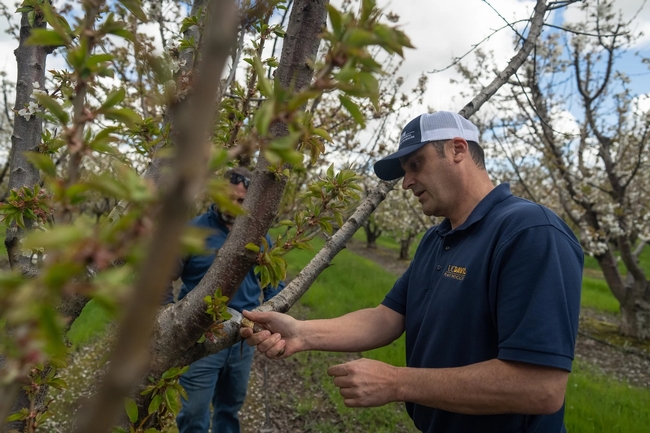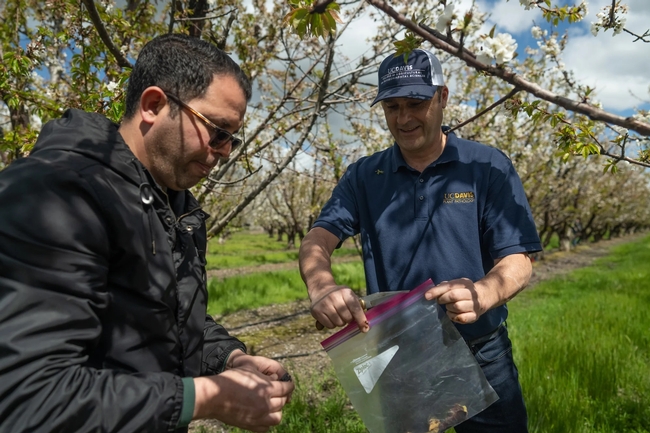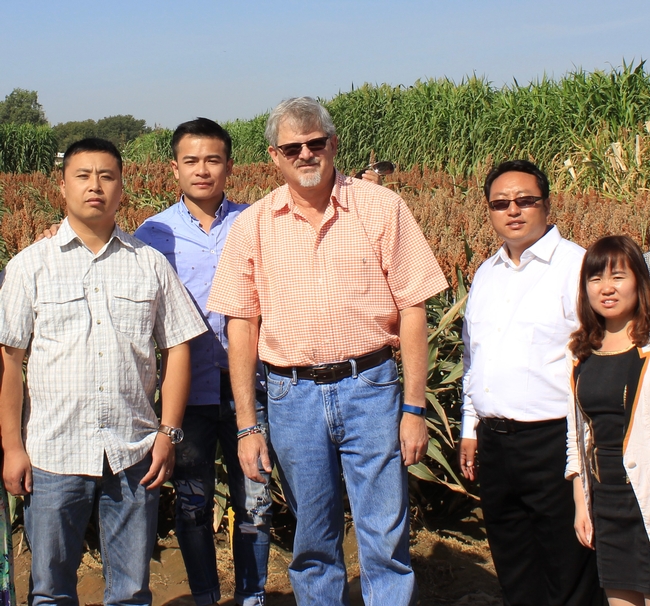Posts Tagged: Kearney REC
Winter atmospheric rivers gave pathogens, diseases path to infect crops
Outbreaks similar to El Niño-influenced issues of the 1990s
The wave of atmospheric rivers that swept across the state this winter has created the right conditions for plant pathogens that haven't been seen for decades in California. University of California, Davis, plant pathologist Florent “Flo” Trouillas is getting more calls from growers and farm advisors concerned about potential crop damage.
“Generally, whenever you have rain events, you're going to have problems,” said Trouillas, a Cooperative Extension specialist who is based at the Kearney Agricultural Research and Extension Center in Parlier. “In wet years we get really busy because most pathogens need and like water.”
Trouillas is like a disease detective. He splits his time between the field and the lab, working to diagnose pathogens, diseases and other ailments that strike fruit and nut crops such as almonds, cherries, olives and pistachios.
On a recent visit to an almond orchard near Fresno, Trouillas joined Mae Culumber, a nut crops farm advisor for UC Cooperative Extension Fresno County. A few weeks earlier, the two had walked the orchard, taking note of the base of some trees that had gumming — a thick, jelly-looking substance indicating a pathogen had taken hold.
“A lot of what Florent is doing is trying to assess patterns on a landscape,” Culumber said. “Sometimes things may look like they are one thing, but it could be another problem.”
When the two returned weeks later, the amber-colored gumming had moved into the canopy, looking like gumballs stuck to branches, some of which were already dead. “It's getting out of control from before,” Trouillas says. “This branch was killed. This is widespread.”
From the field to the lab
Lab testing confirmed what Trouillas believed was the culprit: Phytophthora syringae, a pathogen that can affect almond crops but is rarely seen in California. If it is found, generally the site of infection are wounds caused by pruning, but that is not the case here, where the infection began in the canopy at twigs, or small branches.
It is a threat to a key crop, which according to the California Department of Food and Agriculture, generates $5 billion annually. The last time Phytophthora syringae hit California was in the 1990s after a series of El Niño-influenced storms. Trouillas, who has a photographic memory, remembered reading about it in an old manual.
“It's rare for California and one that we see mostly following atmospheric rivers,” he says.
“The disease will only happen following these extremely wet winters.”
Phytophthora is soilborne, mostly found in tree roots, and doesn't generally spread up into branches. But the intense storms created the right conditions for the pathogen to “swim” up trunks as winds blew spores into the air and rain dropped them back down into the canopy, Trouillas said.
Some of the trees in this orchard will die; others can be saved by pruning infected branches and applying a recommended fungicide, he said.
Identification, diagnosis, education
Trouillas is one of more than 50 Cooperative Extension specialists at UC Davis and each is charged with identifying problems and developing solutions for those issues in support of agriculture, the ecosystem and communities throughout the state.
In his role, Trouillas focuses not only on pathology and research but also on educating growers, nursery staff, pest control advisers and others in agriculture about ways to manage potential threats and how to prevent crop damage.
“His role is very crucial,” said Mohammad Yaghmour, an orchard systems advisor for UC Cooperative Extension Kern County. “He's not only on this mission to educate growers but he's also a source of education for us.”
Trouillas typically conducts one or two site visits a week, usually after a farm advisor reaches out about a problem they can't solve on their own.
“This allows us to be at the forefront of disease detections in California,” he said.
He likens these visits to house calls a doctor would make, only to fields instead. And one of those calls recently took him to a cherry orchard in Lodi.
“These guys help me quite a bit,” said Andrew Vignolo, a pest control adviser with Wilbur-Ellis who asked for a consult. “I bug them a lot.”
The visit starts like any consult in a doctor's office, only the questions come fast as they walk around the Lodi orchard where branches are dying, there is gumming and the trees appear stressed. Some look to be sunburned from exposure. Old pruning wounds show cankers, indicating that past disease treatments didn't get rid of whatever was affecting the trees.
Trouillas asks about the cultivar of the trees because some varieties are more susceptible to pests or diseases. He focuses on stress because that opens the door to disease.
Do they prune in the dormant winter months or in summer when pathogens are more prevalent? Does the soil get tested? How old are the trees? What about nutrition?
“I'm trying to figure out how they got infected so bad,” Trouillas said, walking the orchard. “Bacterial canker is a very mysterious disease.”
He thinks it might be a bacterial canker disease and shaves some bark to take to the lab for testing. He wants to come back next winter to take some samples to see where the pathogen is overwintering.
“We'll know in a few weeks if we have a fighting chance,” Vignolo said.
Be it Lodi, Fresno or elsewhere in the state, Trouillas focuses on local conditions. But what is learned in one field can be passed on to others, providing early warnings or advice for those in similar situations. “All these efforts at collaboration, from the field, to the lab, going through research projects, there's only one goal here — to help the farmers of California.”
Director of the UC Kearney Research and Extension Center retires
UC Cooperative Extension specialist Jeff Dahlberg, also the director of the UC Kearney Agricultural Research and Extension Center (KARE) in Parlier, invoked his 35 years of sorghum expertise to increasing interest in growing the crop in California and to better understanding plants' ability to tolerate drought. Dahlberg retires Jan. 8.
As a Peace Corps volunteer in Niger in the early 1980s, Dahlberg was intrigued by sorghum, a staple food being cultivated by the country's vast population of subsistence farmers.
“I was impressed with the fact that sorghum was so drought tolerant,” Dahlberg said. “Nigerien farmers relied solely on rain for their sorghum and millet crops.”
Upon returning to the U.S., he earned a master's degree at the University of Arizona and a Ph.D. at Texas A&M, where his research focused on sorghum. He worked with the USDA Agricultural Research Service in Puerto Rico for 7 years and then spent the next 10 years as research director with the National Sorghum Producers in Lubbock, Texas.
When Dahlberg took the helm of the 330-acre UC agricultural research center in 2010, he and colleagues at the UC West Side Research and Extension Center and at UC Davis began conducting sorghum forage variety trials. Sorghum wasn't new to California. In the past, it had mainly been used for animal feed. But Dahlberg believed the crop's adaptability – excellent for forage, biofuels and gluten-free human food – offered the grain a rosy future in the Golden State.
"With our research, we have provided California farmers who are thinking about growing sorghum access to locally generated, research-based information to help them make the decision," Dahlberg said.
In 2015, Dahlberg and UC Berkeley specialist Peggy Lemaux launched a sweeping drought research project at KARE. The five-year study, funded with a $12.3 million grant from the Department of Energy, researched the genetics of drought tolerance in sorghum and how soil microbial communities interacted with sorghum roots to battle drought stress.
A journal article published in Proceedings of the National Academy of Sciences in 2018 presented the first detailed look at the role of drought in restructuring the root microbiome. The plant switches some genes on and some genes off when it detects water scarcity and access to water.
“That has implications for feeding the world, particularly considering the changing climate and weather patterns,” Dahlberg said.
In recent years, Dahlberg helped reestablish tea research at Kearney, initiated nearly 60 years ago in a study funded by Thomas J. Lipton, Inc. At the time, Lipton was seeking to grow tea for the instant tea market. When the Kearney tea research program was scrapped in 1981, a researcher had a handful of the best tea clones planted in the landscape around buildings at Kearney.
Those shrubs became the basis for a new tea research trial planted at Kearney in 2017 with UC Davis professor Jackie Gervay Hague to determine whether drought stress impacts the production of phenolics and tannins in the tea.
“We know we can grow good tea here and we can grow high tonnage,” Dahlberg said. “We want to determine if we can do that on a consistent basis and whether we can improve tea quality through irrigation management.”
In retirement, Dahlberg plans to relocate to Lake Ann, Mich., to be close to family. UC Cooperative Extension irrigation specialist Khaled Bali will serve as interim director of the UC Kearney Agricultural Research and Extension Center.





